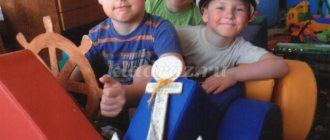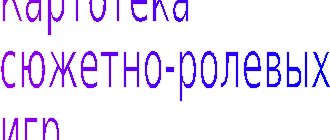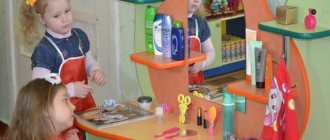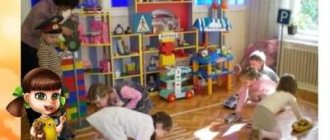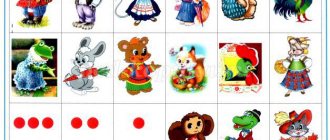Type of project : creative.
Project duration : one week.
Project participants : children of the preparatory group, group teachers.
Educational field: cognition; formation of a holistic picture of the world.
The goal of the project : to form in children an idea of what a circus is. Create conditions for the development of children’s cognitive and creative abilities in the process of a specially simulated situation.
Project objectives:
* Develop children's search activities:
-ability to define tasks based on the problem posed;
-the ability to plan the stages of your actions;
* Improve the level of accumulated practical skills;
* Activate children's speech;
* Strengthen the ability to carry out game actions according to verbal instructions;
* Improve the style of partnerships;
* Foster a desire to play in a group of peers.
Preliminary work:
- Conversations about wild animals.
- Looking at illustrations of animals.
- Visit to the zoo, circus.
- Conversations with children from personal experience.
- Didactic games “Who eats what?”, “Whose baby?”, “Who moves how.”
- Riddles and poems about animals.
- Exhibition of drawings “My favorite animal”.
- Puppet theater “Cat House” S. Marshak.
- Outdoor game “Hunters and Animals” (throwing).
The role of parents in the implementation of the project: assistance in making attributes.
Participation of preschool educational institutions specialists:
- Visual arts classes.
- Selection of musical accompaniment.
- Making attributes.
Project presentation : Circus performance, design of a photo exhibition.
Distribution of activities by stages of the Circus
| Stages | Activities of a teacher | Children's activities |
| I Outlining the plot outline. Identifying the problem. | 1. Formulates the goal: to enrich the experience of children. - select appropriate literature, riddles and poems about animals - illustrations “Animals of hot countries”, “Animals of the North” - video films “Elephant”, “Penguins”, “Bear” - Didactic games “Who is what?” eats?", "Who moves how" | Take active part (listen, ask questions, answer questions posed) |
| II | 1. Formulates the problem. Goal: replace sick performers and perform in the circus arena. 2. Introduces a game situation: the group received a letter from the director of the circus.3. Formulates problems. - How to get to the circus? (go by bus) -How to get to the circus? (to buy tickets) -Who will perform in the circus arena? | 1. Children are part of the problem. 2. Get used to the game situation, perceive the problem.3. They accept the task of providing assistance to sick artists. 4. Clarify the tasks. 5. Children’s search activity when answering questions. |
| III | 1. Leads to problem solving.2. The teacher helps plan children’s activities and activates their initiative in play activities with attributes. | 1. Plan activities.2. Assign roles. |
| IV | 1. The teacher organizes work on the project (stage by stage: search for solutions, choice of role).2. Provides practical assistance (if necessary). | 1. Looking for solutions to problems.2. Select the necessary attributes to display the presentation. 3. Jointly agree on the sequence of actions. Along the way, they make additions and conclude that the speech is complete. |
| V | Carrying out a circus performance. The teacher takes part (helps as needed). | 1. They perform in front of the audience, at the teacher’s prompt they find the necessary attributes for their performance. |
| VI | 1. The teacher poses a new problem. | 1. Children determine the goal of the new project. |
Summary of the open lesson on the “Circus” project
Problem: “what is a circus.”
Game motivation: the performers fell ill at the circus.
Goal: to create conditions for the development of children’s cognitive and creative abilities in the process of a specially simulated situation.
Objectives: Develop children's search activities; improve the level of accumulated practical skills; activate children's speech; consolidate the ability to carry out game actions according to verbal instructions; improve the style of partnerships; cultivate a desire to play in a group of peers.
Progress of the lesson:
1. Introduction to the game situation: The group received a letter from the circus, in which the director asks to replace the sick performers.
Definition of the problem: children's actions in the current situation.
2. Statement of tasks:
-how will we get to the circus;
-what you need to do to get into the circus;
-replace the artists and conduct a circus performance.
3. Step-by-step solution to the problem. (Dialogue conversation)
Educator: We received a letter from the circus asking us to replace sick performers. Do you know what a circus is?
Children: Where human artists and animal artists perform.
Educator: What artists do you know?
Children: Clown, magician, strongman, trainer.
Educator: What professions do people still work in the circus?
Children: Cashier, controller.
Educator: How do we get to the circus?
Children: Let's build a car.
Educator: How do we get to the circus?
Children: Let's buy tickets.
Educator: Can we replace sick artists?
Children: Yes, of course we can.
4. Setting further actions:
- building a bus and traveling on it to the circus;
— buying tickets at the circus box office;
- choosing the role of an artist and showing a circus performance.
- return to kindergarten.
5. Presentation of the project: Circus performance, design of the photo exhibition “Circus performance”.
6. Statement of a new problem: Children, together with the teacher, determine a new problem - to perform a new circus program in front of children of junior groups.
Role-playing game "Circus"
Goal: To consolidate children's knowledge about the circus and its workers. Reinforce ideas about cultural institutions and rules of conduct in public places. Develop children's creative imagination, memory, coherent speech, sense of rhythm, tempo, and motor skills. Practice the ability to distribute roles, understand an imaginary situation and act in accordance with it. Strengthen the ability to carry out game actions according to verbal instructions. Foster a desire to play in a group of peers.
Preliminary work: Conversations about wild animals. Looking at illustrations of animals. Visit to the zoo, circus.
Conversations with children from personal experience. Didactic games “Who eats what?”, “Whose baby?”, “Who moves how.” Riddles and poems about animals. Exhibition of drawings “My favorite animal”. Puppet theater “Cat House” S. Marshak. Outdoor game “Hunters and Animals” (throwing).
Attributes: Posters, tickets, programs. Elements of costumes, spouts, caps, whistles, “ears”, rope, rod. “Burning” hoops, balls, makeup. Special clothing for ticket takers and buffet workers.
Playing roles: Driver, circus director, cashier, controller. Clown, trainer, strongman, tightrope walker. "Bears", "penguins", "tigers", "elephant".
Progress of the game:
Presenter: Guys, we received a letter in which we are invited to visit the circus. How many of you have been to the circus? Who is the most important person in the circus?
Children: Circus director.
Presenter: Without whom the performance will not take place?
Children: No circus performers.
Presenter: What circus performers do you know? (Children's answers)
Children: Clown.
Presenter: What does he do? What does he look like? What other artists do you know? (juggler, animal trainer, magician).
Host: What professions do people still work in the circus?
Children: Cashier, controller, toy sellers.
Host: Children, do you want to go to the circus? How will we get to the circus?
Children: Let's build a bus (children are building a bus from chairs). Before we go, let's choose circus performers (distribute roles).
What does Sasha want to become? Why? What does Nastya want to become? Who will I be? (circus director)
Host: Who will be our driver? Take the steering wheel and drive us. Do you know the way?
They come to the circus.
Presenter: What do you need to do to get into the circus?
Children: Buy tickets.
Children approach the cash register. They buy tickets. At the entrance to the hall there is a controller and checks tickets.
Circus director: Dear spectators, come into the hall and take your seats in the auditorium.
The bell rings. The circus director comes out into the middle.
Circus! Circus! Circus!
The circus is great!
It's festive and bright everywhere!
Cheerful laughter rings here!
Everyone is invited to visit!
Director: The first number in our program is strongmen.
A strong boy comes out and lifts dumbbells and a barbell. Applause from the audience.
Director: Our program is continued by trained penguins.
Three penguins come out and perform movements.
A clown runs out and shows his number.
Director: The next act is a trained elephant.
An elephant comes out and performs a dance on a pedestal.
Director: In the circus arena there is a tightrope walker. A very dangerous number. It requires special training. If the tightrope walker stumbles, he will fall down.
The tightrope walker comes out and walks along the rope. The audience watches the performance in complete silence.
Director: The next number is trained bears.
Bears ride scooters.
Director: For the first time in the circus arena, the trainer and his trained predators.
The trainer does not run without looking back.
He is not a timid guy.
Working with animals is dangerous.
You will see it for yourself!
A trainer comes out with tigers or lions. They run from one chair to another, climb through burning hoops.
The audience applauds every performance.
At the end of the performance, the artists enter the “arena”.
Director:
The time for parting comes,
But let's not be sad goodbye
We are always happy to meet again.
The Circus of Miracles says “goodbye!”
Spectators board the bus and return to the kindergarten.
Host: guys, where have you been? What did you see there? Which number did you like best? Would you like to go to the circus again? We will draw up a new program with you and invite guests to the performance.
See you again!
